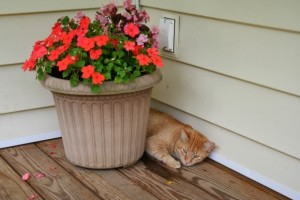Cleaning up the garden in the fall is a necessary, if sad, task. I know I always feel sad as I rake up the dead leaves, pull frost-blighted annuals, and toss brown flowers on the compost pile. Fall cleanup is, however, a very necessary task for several important reasons.
Prevents Insects from Wintering Over in Debris
- Cut back dead foliage on perennial plants. Discard it in the trash if insects or diseases are present.
- Pull out spent annuals and discard them.
- Rake leaves from the grass and garden.
- Deadhead, or snip off the spent flowers on plants such as Echinacea.
- Remove and discard dead vegetable plants.
Other Fall Garden Clean Up Tasks
- Rinse, dry and store pots, especially clay, terra cotta and resin pots and containers, indoors.
- Clean your tools, dry them and store them properly.
- Discard ripped gardening gloves…and start a list of things you need for next year!
- Stock up now on end of year sales on hard goods, such as garden stakes, plant markers and pots.
- Clean bird feeders before refilling and placing them outdoors.
- Take down your hummingbird feeder; clean it and store it for next year.
- Remove small garden accessories that can get damaged by snow.
- Drain fountains and bird baths and store them indoors for the winter.
- Add mulch to tender plants, such as straw mulch around strawberries.
- Place protection around plants such as fig trees that may need protection from frost and cold.
- Make sure you have at least one snow shovel IN the house…just in case you get snowed in!





